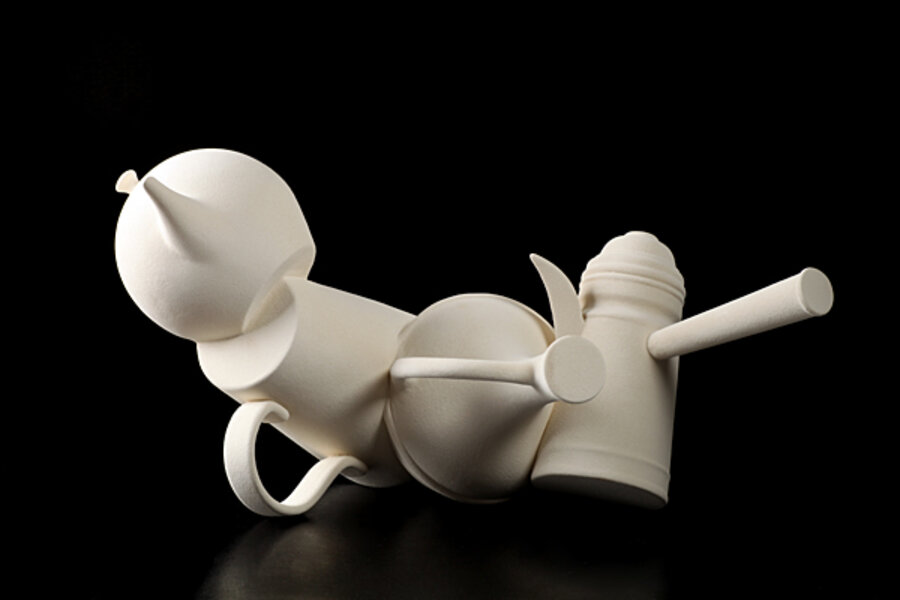Israeli artist Sovar Lerner sees harmony in a teapot
Loading...
| Jerusalem
Israel, a crucible of immigrants from places as diverse as Ethiopia and Lithuania who live interspersed with an indigenous 20 percent Arab minority, simply can't be boiled down into a monolithic Jewishness.
Just ask Israeli artist Sovar Lerner, who is half Persian, a quarter Russian, and a quarter Polish – and married to a man whose parents emigrated from Libya.
Her reply is artful, elegant, yet raw and frank – and will be on display in New York from May 18-22. In a new twist on the melting pot theme, Ms. Lerner has produced a series of ceramic pots melded together, each retaining distinct characteristics yet unquestionably – if awkwardly – part of the jumbled whole.
They include the long handle of an Arabic tea pot, traditionally heated up over a blazing open fire; the simple aluminum pot of the early kibbutz days, where Jewish pioneers eked out a living as the modern state of Israel found its footing; the unique Ethiopian spout, designed for a dramatic pouring of coffee that would cool off on its long trip to the cups below; and the classical pot blending Russian, Chinese, and European styles that would be familiar to Israel's Ashkenazi Jews.
The project is part of a Bezalel Academy of Arts and Design Jerusalem exhibit in New York, where Lerner was inspired by the idea of pluralism.
"It helped me to see how things can be better [in Israel] than they are now," she says.
A perennial if muted tension exists in Israel between the Ashkenazi Jews of Europe and the Sephardic Jews who came from North Africa and Middle Eastern countries. Ashkenazim were dominant in the kibbutz movement, which acquired large tracts of land at minimal cost – a huge capital investment that is reaping significant dividends as numerous kibbutzes are moving away from their agricultural roots and selling or developing their property. Sephardim, in contrast, were often settled in more rural areas and struggled economically though they became a formidable political force by the late 1970s.
In the early 1990s, a wave of more than 1 million immigrants from the former Soviet Union flooded into the country, a community that is still not fully integrated but has produced influential political leaders like Avigdor Lieberman, who is slated to serve a second term as foreign minister if he is cleared of corruption charges in the coming months.
Perhaps the most struggling immigrants are those from Ethiopia, tens of thousands of whom came via spectacular Israeli airlifts in 1984 and 1991 but – along with more recent arrivals – have found it difficult to integrate economically and religiously into Israeli society. The ancient Jewish community in Ethiopia revolved only around the Hebrew Scriptures, not the book of Jewish law and rabbinical teachings known as the Talmud, which is the basis for many of the traditional Jewish customs today, and thus have complained of being treated as "less Jewish" than other Israelis.
RELATED: Youth villages give Israeli immigrant children a place to belong
“Ethiopians are the big issue now,” says Lerner, who hopes her project will help people be more pluralistic. “I hope it will show them how cultures contribute to society, and to other cultures.”
One extraordinary aspect of her sculptures is that there is not a right-side up. No one pot is meant to be on top or on the bottom, so each piece can be turned 360 degrees horizontally as well as 360 degrees vertically, offering a 720-degree view of multiculturalism.
“It’s not who’s dominant, and who’s not,” says Lerner, who hopes to see the exhibit in New York but isn’t sure if she can afford it.
Her unselfishness as a mother may provide the ticket, though: When she was first applying to Bezalel in the late '80s, she discovered she was pregnant and postponed her education by some 20 years. Now, that daughter is 24 and works as a flight attendant for the Israeli airline El Al, so Lerner can get discounted tickets.
“It was my dream” to go to art school, she says. “I didn’t give up on my dream.”







